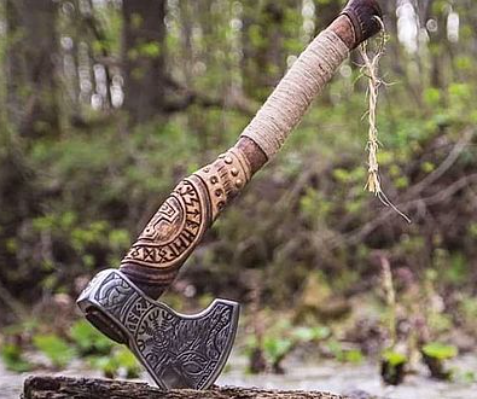In the annals of history, the Vikings stand as symbols of ferocity, exploration, and craftsmanship. Central to their identity were their weapons, with axes and swords emerging as quintessential tools of war and symbols of power. While both the Viking axe and the Viking sword were integral to Norse warfare, they possessed distinct characteristics and purposes that shaped their roles on the battlefield and in Viking culture. Viking axes
Design and Construction
The Viking axe, with its broad, fearsome blade and sturdy wooden haft, epitomized the practicality and versatility prized by Norse warriors. Designed primarily for chopping, cleaving, and hacking, the axe's weight-forward design delivered devastating blows capable of cleaving through armor and bone alike. Its construction varied from single to double-edged variants, with some featuring elaborate inlays and decorations reflecting the owner's status and wealth.
In contrast, the Viking sword represented the pinnacle of Norse metallurgy and craftsmanship. Characterized by its double-edged blade, typically around 30 inches in length, the sword was a symbol of prestige and authority. Crafted with a keen edge and balanced for thrusting and slashing, Viking swords were versatile weapons favored by chieftains and elite warriors. The intricate patterns of the hilt and pommel often bore intricate designs, showcasing the artisanal skill and aesthetic sensibilities of Viking swordsmiths.
Combat Application
On the battlefield, the Viking axe and sword served complementary roles, each suited to different tactical situations. The axe, with its raw power and chopping ability, excelled in close-quarters combat, allowing warriors to deliver devastating blows in frenzied melees. Its effectiveness against shields and armor made it a formidable weapon for raiding and ambushes, where brute force often prevailed.
Conversely, the Viking sword's agility and precision made it ideal for thrusting and slashing in duels and skirmishes. Its longer reach and balanced design enabled warriors to engage opponents at a distance, exploiting vulnerabilities in armor and exploiting openings with quick, decisive strikes. While less effective against shields and heavy armor compared to the axe, the sword's versatility and finesse made it a favored weapon among Norse nobility and seasoned warriors.
Cultural Significance
Beyond their martial prowess, both the Norse axe and sword held profound cultural significance within Norse society. The axe, with its roots in ancient Scandinavian farming and woodworking traditions, symbolized strength, resilience, and the connection to the natural world. Its utilitarian design and association with everyday tasks underscored the Vikings' pragmatic approach to warfare and survival.
Conversely, the sword embodied the ideals of honor, prestige, and social status among the Norse elite. Passed down through generations as heirlooms and symbols of lineage, Viking swords were often imbued with mythic narratives and imbued with spiritual significance. As markers of authority and leadership, they played a central role in rituals, feasts, and ceremonies, solidifying the bonds of kinship and loyalty within Norse society.
In the saga of the Vikings, the axe and sword stand as enduring symbols of martial prowess, craftsmanship, and cultural identity. While the axe represented the raw power and pragmatism of Norse warfare, the sword embodied the ideals of honor, prestige, and lineage among Viking chieftains and nobility. Together, these iconic weapons forged the legacy of the Vikings, leaving an indelible mark on history and inspiring generations to come.

